Brief

Executive Summary
- Covid-19 and stricter regulatory rules on capital will put a drag on European banks’ return on equity and capital. To counter these challenges, banks should syndicate and securitize more of their loans and other credit risk exposures.
- The opportunity is worth an additional 1.5 percentage points of return on equity (ROE), we estimate, which would put the banks on track to a sustainable level.
- Borrowing companies and investors would also benefit from the additional securitization.
- Doing this effectively entails choosing the appropriate management model and aligning the relevant stakeholders inside the bank.
It’s a trying time for European banks—even an existential moment for some—as they face structural challenges to their profitability. Stricter regulatory rules on capital, including full implementation of Basel IV standards, will create a significant capital shortfall and put a further drag on banks’ return on equity (see Figure 1). The additional stress on balance sheets caused by Covid-19 and its lockdowns (in terms of credit migration and loan defaults) further threaten the sustainability of their current business models.
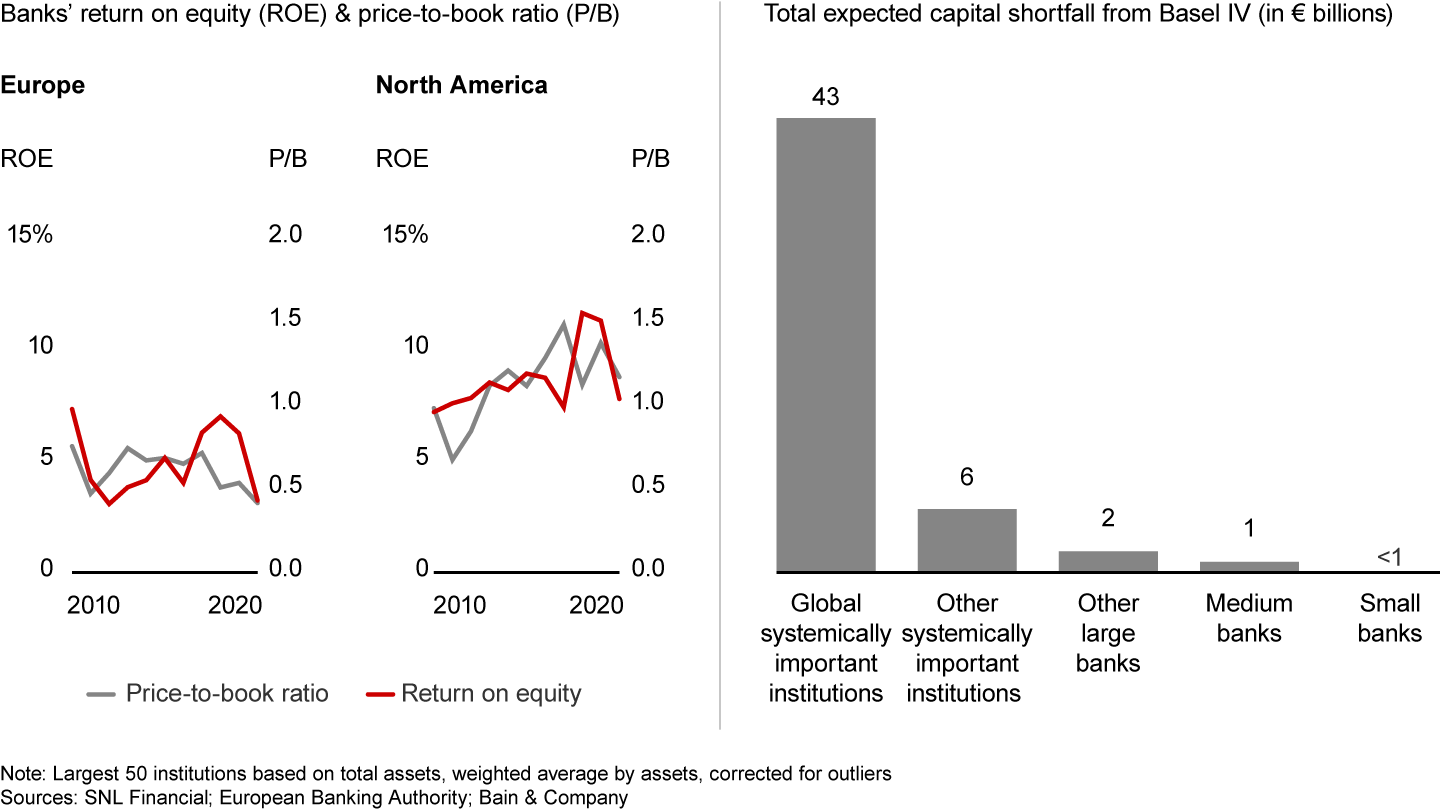
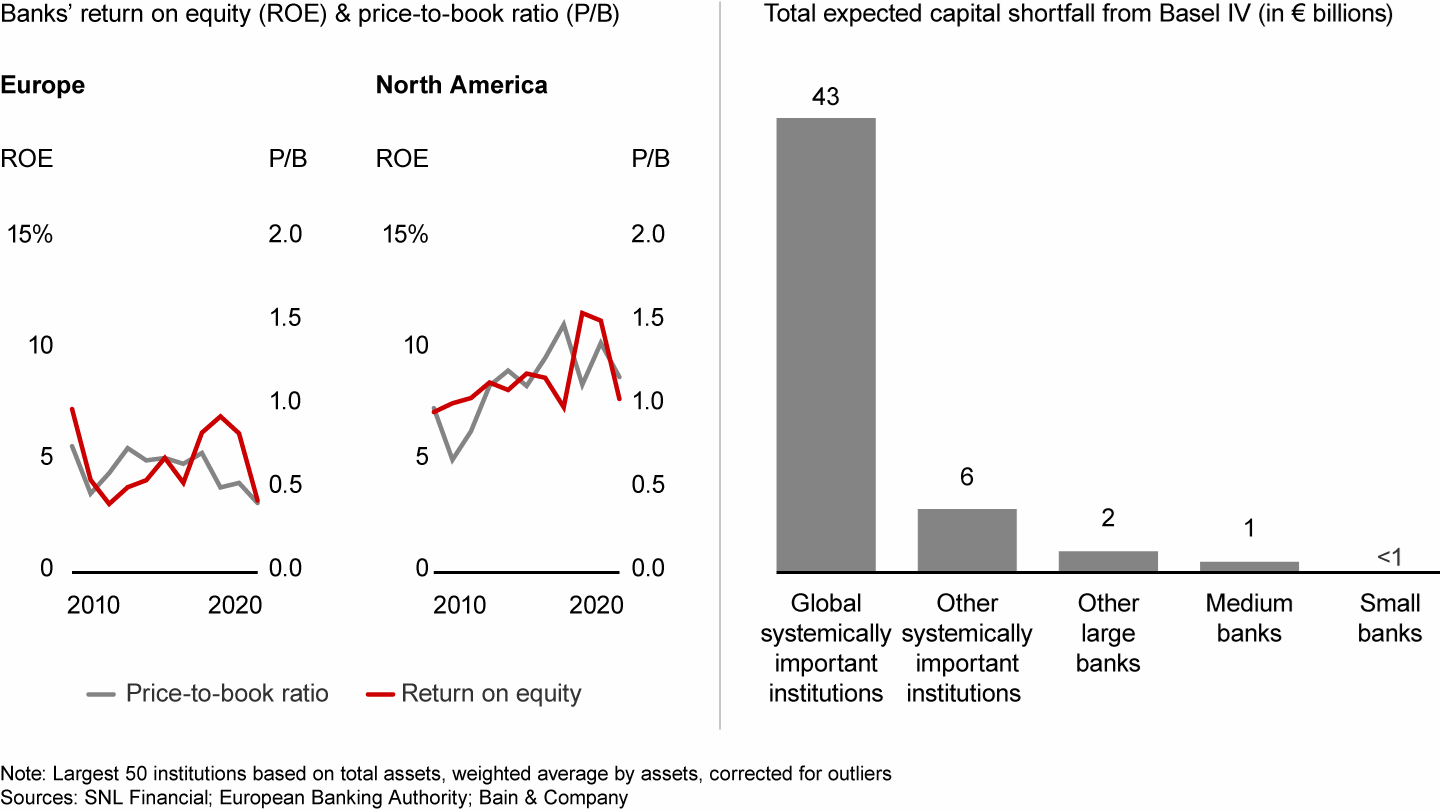
To address these challenges, the most effective strategy is for banks to manage their balance sheet and capital holistically. In particular, they can syndicate and securitize more of their loans and other credit risk exposures (e.g., from long-dated swaps), just as major US banks such as JP Morgan, Citi, and Goldman Sachs have successfully done. This would allow European banks to minimize the drag on capital while improving customer relationships by offering more tailored products without assuming all of the risk.
The opportunity here is substantial. To estimate its size, we compared the issuance of securitized products by US and European banks as a baseline for broader risk syndication, including private transactions. From 2018 through 2020, US banks placed securities worth an average of about 6.5% of their balance sheets. European banks, by contrast, placed securities worth just 0.4%. This gap is particularly pronounced in 2020, with US banks demonstrating flexibility to structurally change their balance sheets in the face of the Covid-19 crisis, significantly increasing their share of placed securities compared to the previous year. European banks, in contrast, reduced securitization in 2020.
We extrapolated the average gap from 2018 through 2020 to include broader syndication and securitization along with the corresponding fee income and cross-selling possibilities. The resulting improvement in ROE would reach roughly 1.5 percentage points, which would put the ailing European banking sector on track to a more sustainable level—even if not at the North American standard, which has been about 5 percentage points above Europe. Higher profitability means greater scope for building capital through earnings retention, which will help attract investors who have been shying away from low returns in Europe.
Fortunately, political tailwinds are building from the 2020 EU Capital Markets Union Action Plan to foster securitization as a means to help banks transform their respective economics. Leading banks have already started to take control of their balance sheets and capital management and revise their approach to managing balance-sheet efficiency and velocity. Those that act swiftly and definitively will likely emerge in winning positions on par with their US rivals, while laggards will spiral down.
Go forth and syndicate and securitize
Banks wrestle with a wide spectrum of potentially conflicting objectives. To shore up capitalization and profitability, banks must increase asset velocity and optimize the mix of credit demand and supply. They also want to remain relevant to investors who are hunting for yield while still abiding by regulatory constraints. The way to accomplish these multiple objectives is through integrated balance-sheet and capital management.
The heart of this approach relies on systematic syndication and securitization of a bank’s credit risk in its various portfolios. This reduces both the capital required and the revenues generated because risk sharing implies revenue sharing. However, banks can capture additional fees on the syndicated and securitized volume, which frees up capital to reinvest at equal or higher returns.
To illustrate the process, consider the case of a German automotive components firm that requires a loan in order to fund a large acquisition in US dollars (see Figure 2). Because this firm has no public rating or direct capital markets access, the firm cannot in practice issue bonds directly. The large loan size or the company’s industry likely makes it too expensive or risky for a single bank to commit the full credit line on its own.
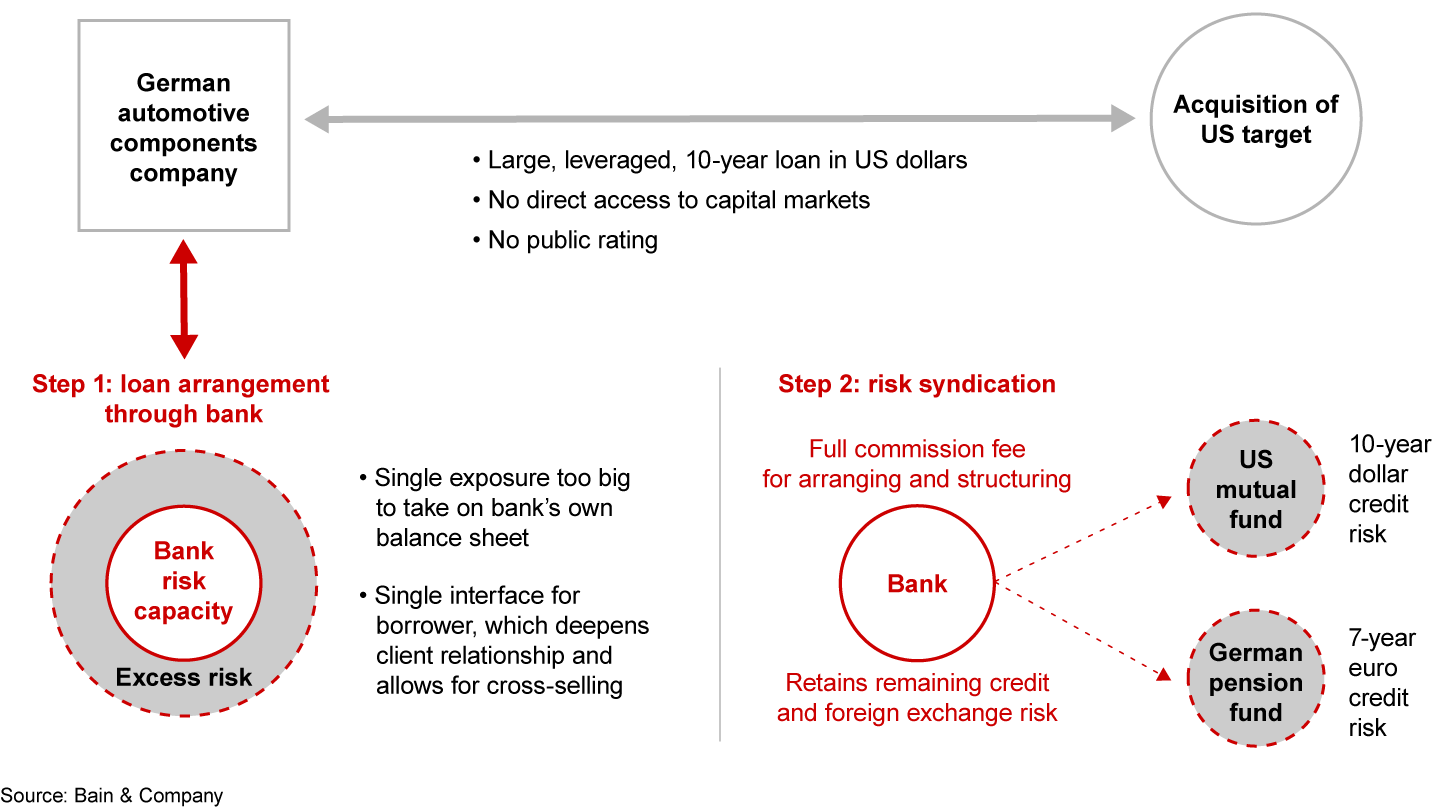
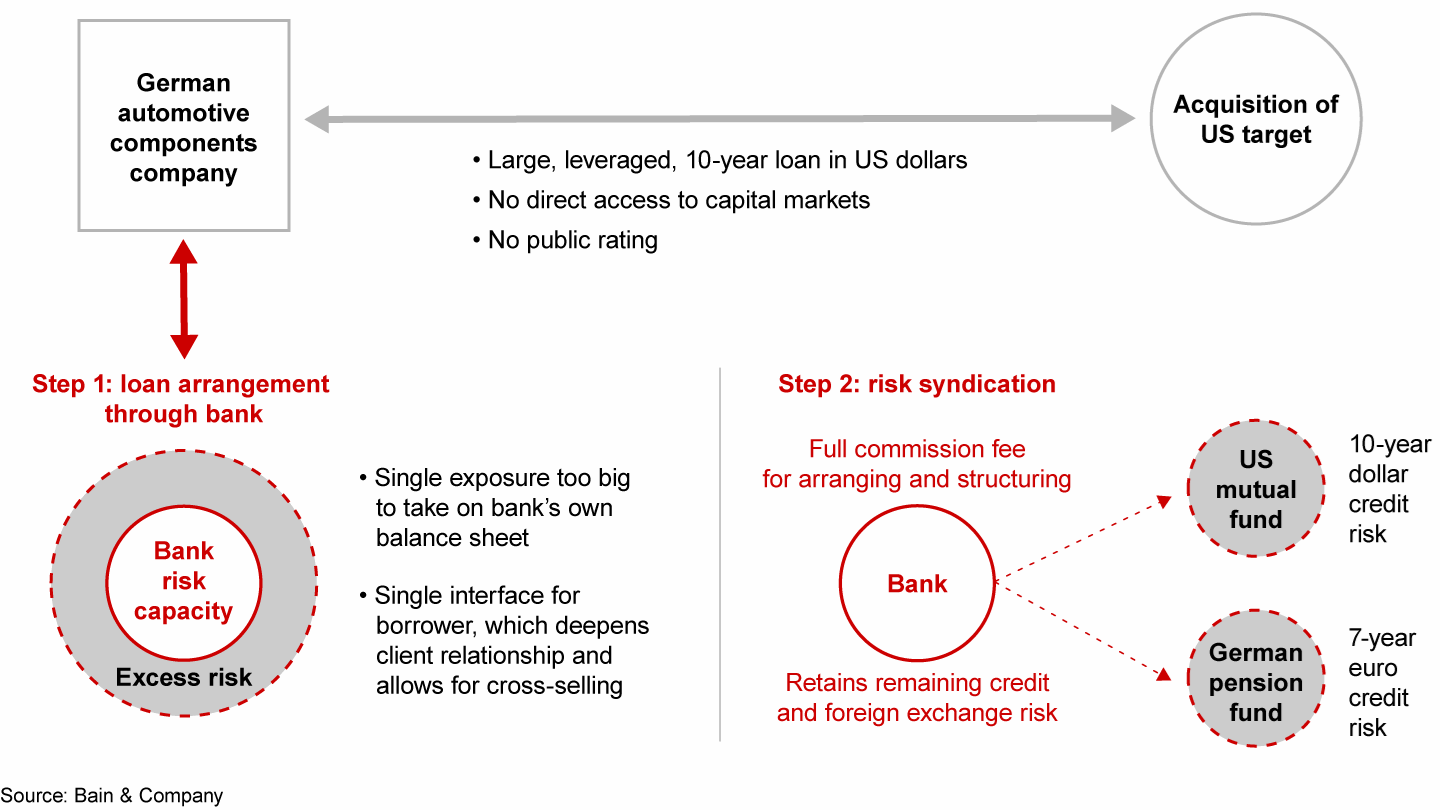
However, a bank with integrated balance-sheet and capital management might be able to help the automotive components firm by syndicating the risk of the leveraged loan at full notional value. This might take the form of direct securitization or restructuring the risk exposure by selling tranches of credit risk and foreign exchange risk and adapting the amortization to meet investors’ needs. For a 10-year loan in US dollars, the bank might retain part of the junior tranche in dollars while passing on the rest of the tranche to a US mutual fund. For the senior tranche, if there was no direct demand for its maturity, the bank could sell the 7-year euro credit risk to a German pension fund while keeping the euro or dollar exposure as well as the tail risk.
Two investors—the US mutual fund and the German pension fund—now benefit from gaining access to this new credit risk. The bank can charge a commission for access, calibrated to comparable market rates and liquidity premiums. Because the bank typically must pull the transaction through its balance sheet and may retain parts of the risk, the regulatory cost of the temporary ownership and partial risk retention must not exceed the benefit gained in the form of the commission fee.
How each party benefits
This transaction thus benefits the German automotive components company, strengthens its relationship with the bank, provides a bespoke opportunity for investors, and earns a profit for the bank. Freeing up capital gives the bank more capacity to take on new business because it does not need to wait for portfolio transactions to mature. The only remaining constraints are the bank’s appetite for risk and its ability to transfer some of that risk.
Hence, increasing asset velocity makes risk-weighted assets more productive. It combines the net effects from reducing capital drag on inefficient parts of the portfolio (such as low-quality loan books), adding fee income on syndication and securitization, and increasing the volume of new or additional business. A bank would need to scan its existing portfolio and identify opportunities, such as selling long-dated interest rate swap portfolios—even at a discount to the original pricing, if it benefits the overall capital allocation. Any such move must also be feasible for the firm looking for financing; for instance, the German automotive components company in our example may not want to sell debt to a US hedge fund, believing the hedge fund would be less tolerant if the company was to default.
Greater maneuverability with the balance sheet, with resources directed to the areas generating the most value, allows banks to readily adapt to changing regulatory and competitive dynamics. Overall, banking operations would become more stable, scalable, and profitable. Banks would still be exposed to credit and settlement risks, so they will want to carefully manage portfolio quality while setting the right long-term incentives.
Three basic organizational models
Banks will have to choose the type of management model that best suits their situation and decide which related instruments and steering mechanisms they will use to manage complexity. To simplify, there are three basic model approaches, ranging from straightforward functional service units to a more transformative approach that consolidates full P&L responsibility when it comes to resource allocation:
- Service unit. A functional service unit with placement and securitization capabilities acts as an advisor to client-facing divisions. More detailed allocation of capital and resources, along with P&L responsibility, remains with those divisions. This model is easy to implement but has a limited effect on the balance sheet and profitability.
- A virtual warehouse. Besides setting up a service unit, the bank increases transparency via virtual transfer prices based on market benchmarks, such as tracking the level of cross-selling value. The service unit also actively recommends optimal capital and resource allocation although the business still owns assets and the P&L responsibility. This improves balance-sheet utilization and profitability.
- Full-fledged optimization. This model actively manages balance sheet and capital. The unit goes all in with transfer pricing, effectively buying all assets from client-facing divisions and taking full P&L responsibility, including placement, syndication, and balance-sheet cost. It becomes a profit center with the P&L statement distributed back to client-facing divisions based on full-value contribution at year-end. While this approach takes significant effort to build, it enables a bank to reap the full potential from integrated balance-sheet and capital management.
The choice of model should align with the bank’s strategic focus and business situation (see Figure 3). Global universal banks, for example, typically run a full-fledged model across all instruments. By contrast, a more straightforward service unit might better suit regional banks.
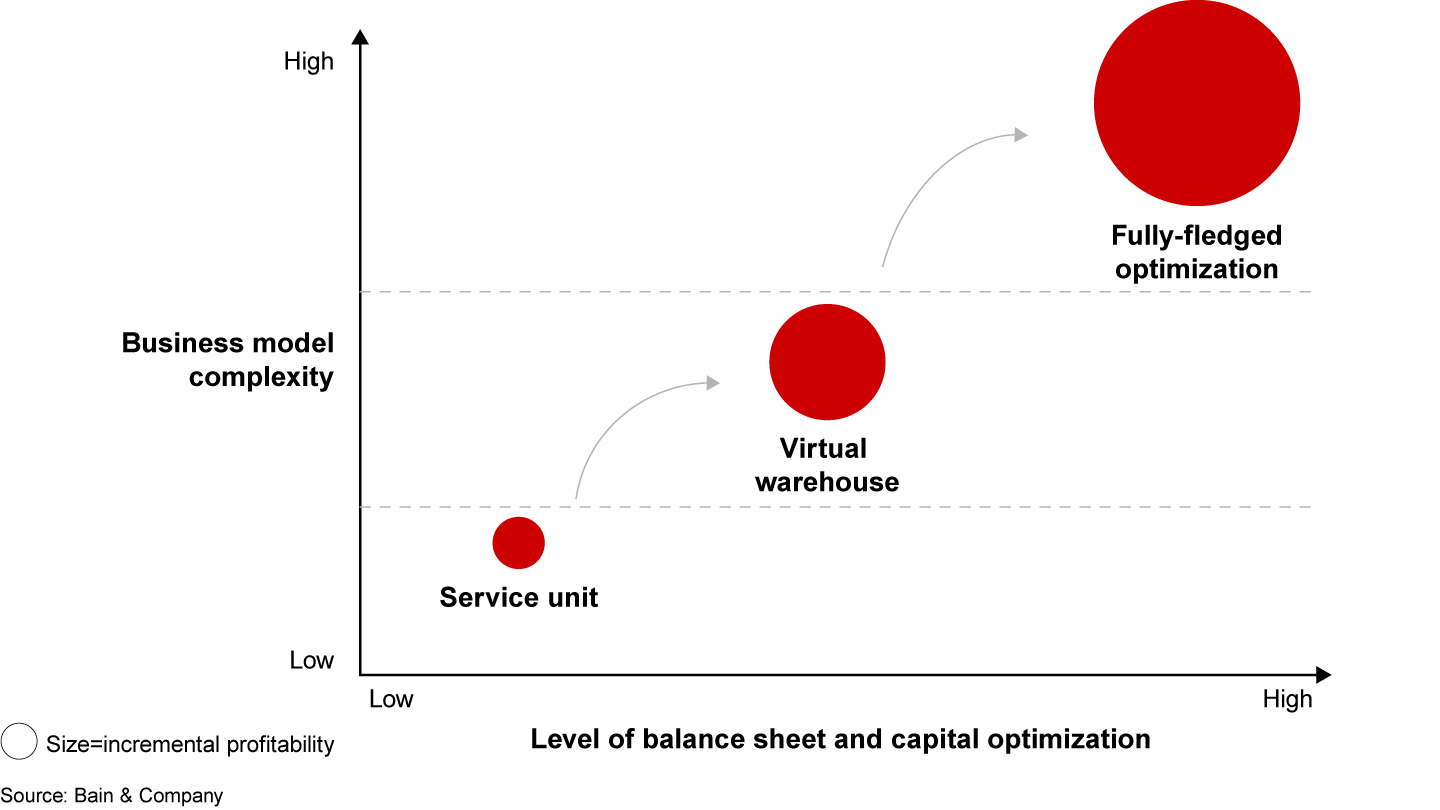
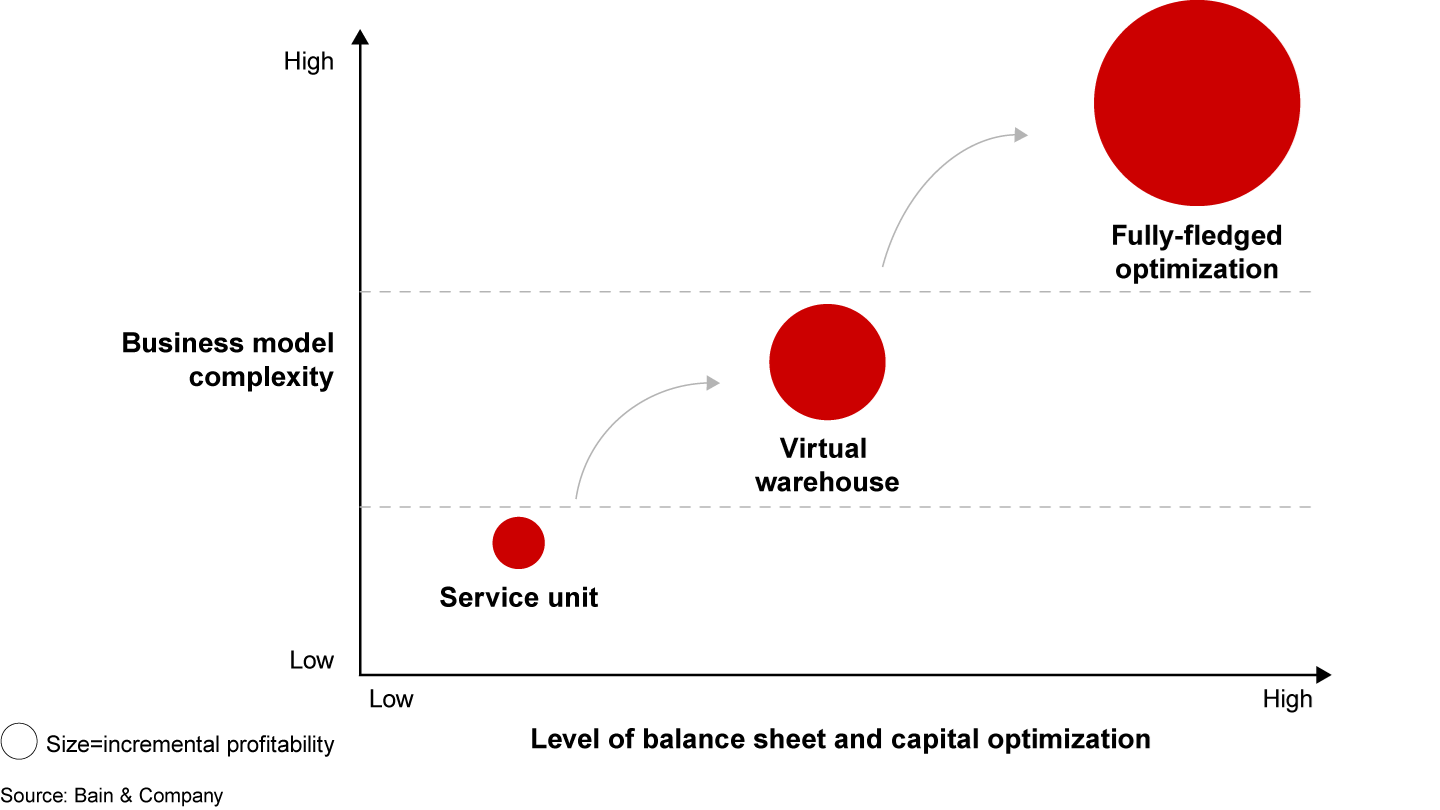
With any of the models, though, an integrated management unit is not an investment office aiming to generate revenue by taking on additional risk, as often occurred in the run-up to the global financial crisis of 2007. Its structure and incentives should be designed to optimize and reduce the risk banks take for a given return.
Coordinating all the roles
Success with integrated balance-sheet and capital management requires alignment among all the relevant stakeholders, including the bank’s business units, risk, finance, and other central management functions. This might seem obvious, but getting divisions within a bank to collaborate on the initial setup and ongoing operations is not an easy task. For instance, there could be conflicts of interest to resolve, such as who takes the ultimate P&L responsibility or how to structure the respective compensation and incentive model.
At each stage in implementation, then, all stakeholders must explicitly confirm how they are advancing the chosen approach. That collaboration should carry through each of the following five steps:
- Align on specific objectives. Before working out the details of what an integrated approach looks like, it’s important to arrive at a common understanding of overall objectives and long-term expectations. The success of any approach ultimately depends on bringing together and coordinating different parts of the bank.
- Define how the organization will operate. There are fundamental choices to make about setting up the approach, including the roles for each part of the bank and external stakeholders. Long-standing customers, for instance, may perceive the bank as their home bank for the provision of loans. The model has to work within the bank’s particular culture and context.
- Agree on pricing mechanisms and origination and syndication metrics. Based on the model chosen, details about how origination and syndication units will work together and how to measure success will have to be determined. In the full-fledged version, this involves a high degree of stakeholder participation.
- Devise steering methods and incentives. The means of governance and incentives should be embedded in the bank’s operating model, not run off to the side. An isolated solution is doomed to fail at delivering significant value.
- Map out the sequence of implementation. The process of ramping up an approach should be thought through before starting. Moreover, a one-time effort will not unlock the full potential so the approach will require regular calibration.
Europe’s banking models, with returns and valuations lagging behind their US peers, are headed into choppy waters with the onset of increasing capital requirements and diminishing returns. They have a powerful tool at hand to boost profitability and ensure their continued relevance—if they commit to overhauling their balance-sheet and capital management with an integrated approach.